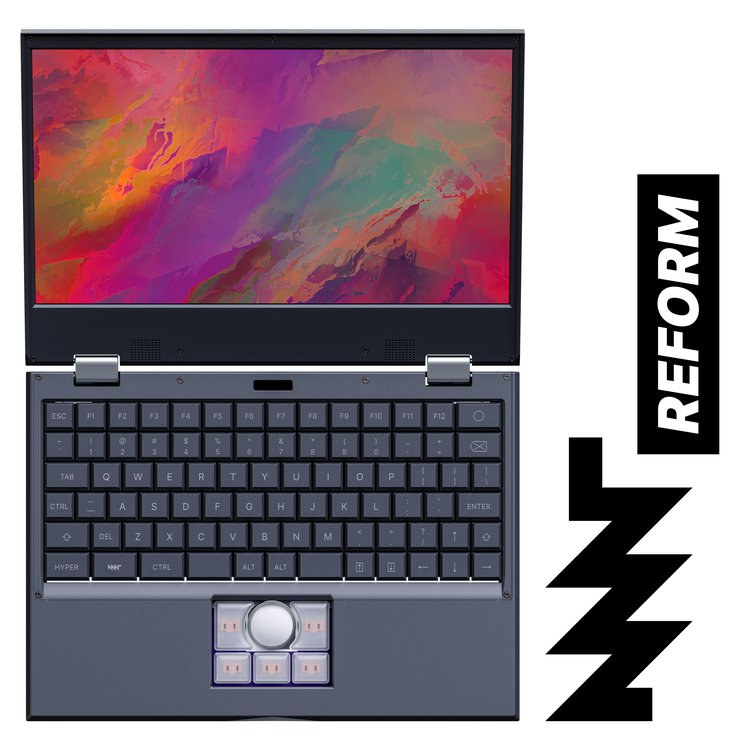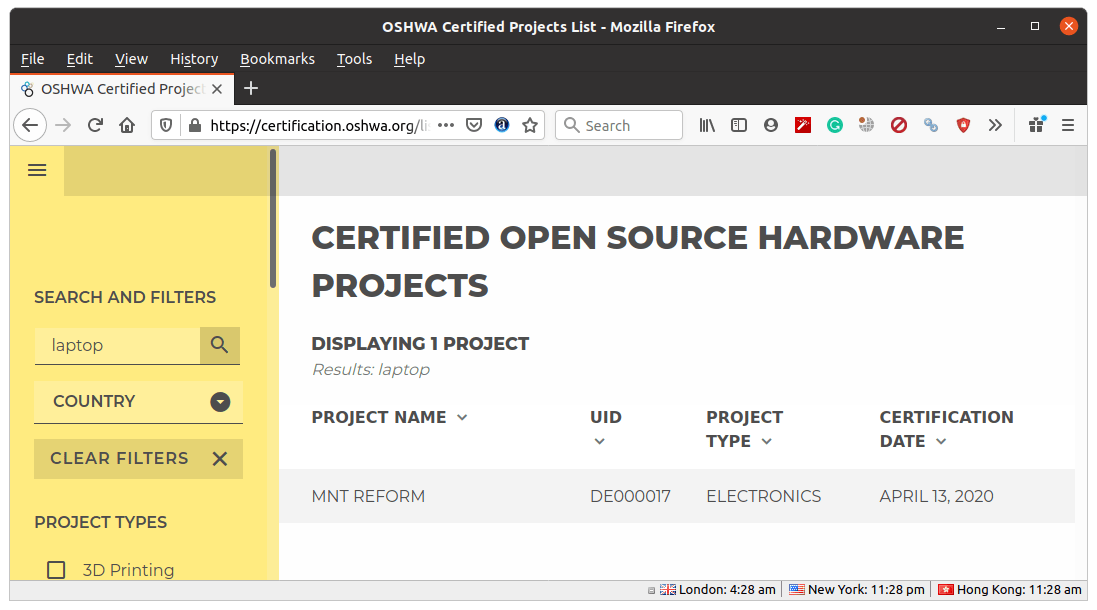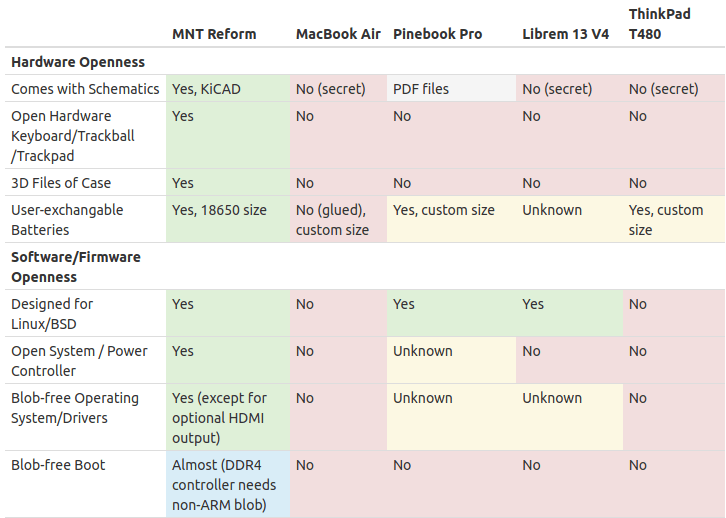MNT Reform DIY Arm Linux laptop has been in the works at least since 2017. The open source hardware laptop is also fully modular with Boundary Devices Nitrogen8M SoM featuring NXP i.MX 8M quad-core Cortex-A53 processor and 4GB RAM, M.2 NVMe SSD storage, and standard, replaceable 18650 batteries.
The good news is the laptop is now almost ready for prime-time and has been launched on Crowd Supply with price starting at $999 in DIY kit form without storage, and $1,300 for a complete, assembled system with 256GB NVMe storage. If you don’t have that amount of money to spend, but would like to support the project, a $40 MNT Reform T-shirt is also offered. Alternatively, the motherboard only goes for $550.
 Here’s a reminder of MNT Reform specification:
Here’s a reminder of MNT Reform specification:
- SoM – Boundary Devices Nitrogen8M
- SoC – NXP i.MX 8MQuad quad-core Cortex-A53 processor @ 1.5 GHz, 1x Arm Cortex-M4F real-time core Vivante GC7000Lite 3D GPU
- System Memory – 4GB LPDDR4
- Networking – Atheros Ethernet MAC chip (AR8035)
- 200 pin SO-DIMM edge connector exposing USB 3.0, PCIe, MIPI DSI, etc…
- Dimensions – 67.6mm x 48.4mm
- Motherboard
- Storage
- SD card slot, M.2 SSD support
- MNT Reform DIY Kit – No storage device included
- MNT Reform – 256GB NVMe SSD
- MNT Reform Max – 1TB NVMe SSD
- Video Output
- Texas Instruments SN65DSI86 MIPI DSI to eDP controller for the display
- HDMI output up to 4K
- Audio – Wolfson/Cirrus WM8731 audio DAC; headphone/microphone jack; amplifier driving two 1W speakers
- Networking – Gigabit Ethernet (RJ45), optional mini PCIe ath9k Wi-Fi card (included in MNT Reform Max)
- USB – Texas Instruments TUSB8041 USB 3.0 hub chip for the trackpad, keyboard, and three USB 3.0 Type-A ports
- Expansion Slots
- M.2 M-key slot for NVMe SSD
- mPCIe slot for WiFi card, an embedded graphics card, FPGA board, etc..
- System Controller – NXP LPC11U24 Cortex-M0 MCU to control an analog monitor chip for the 8 battery cells and the charger.
- Power Supply – 24V/2A via barrel jack
- Storage
- Displays
- 12.5″ IPS eDP (embedded DisplayPort) panel from Innolux, with 24-bit color and 1920×1080 resolution.
- 128×32 pixel OLED display on top of the keyboard
- Camera – No camera included, but internal MIPI CSI connector present
- User Input
- Keyboard – ANSI layout with 80 mechanical low-profile Kailh Choc switches
- Trackball – 5 buttons and a small surface tracking sensor
- Optional trackpad as an alternative to the trackball
- Batteries
- Replaceable 8x 18650 LiFePO4 battery cells with a nominal voltage of 3.2V (meaning an operating voltage of 28.8V).
- Capacity -12,000 mAh good for about 5 hours of use
- Case parts
- Screen Back for housing the display and upper half of hinges.
- Screen Front for housing speakers and providing display bezel.
- Main Box for all boards, keyboard, battery board…
- Main Box Top to provide a bezel for the keyboard and the system controller OLED.
- Main Box Bottom either milled from clear acrylic or aluminum.
- Dimensions – 29 x 20.5 x 4 cm
- Weight – ~1.9 kg
- Certification & Licenses – OSHWA (Open Source Hardware Association) #DE000017 with CERN OHL-2.0-S (hardware), GPL 3.0 (software, firmware) and CC-BY-SA 4.0 (documentation, artwork) licenses
MNT Reform is the one and only OSHWA certified laptop that I could find (on May 9, 2020), but not the first “open source hardware” laptop running Linux, with for example PineBook Pro which is virtually unbeatable in terms of price ($200) and performance (Rockchip RK3399). However, MNT Reform has a fairly different design philosophy as openness, user serviceability, and modularity were the main goals, even guiding some hardware design decisions that increased the price of the device.
All hardware design files have been released, and the software (Debian 11 installer with Linux 5.x mainline preloaded on MicroSD card) can operate with open-source only components, except for the RAM. Some specific features that you may optionally opt to use do require closed-source binary blobs including HDMI output (HDCP blob). You’ll find hardware (KiCad), 3D design, and software on the MNT Reform website.
The crowdfunding campaign launched less than 24 hours ago, and it’s not going too bad with $60,000 raised out of $115,000 funding target. The prices listed in the introduction include free worldwide shipping, and backers should expect their rewards to ship in December 2020.

Jean-Luc started CNX Software in 2010 as a part-time endeavor, before quitting his job as a software engineering manager, and starting to write daily news, and reviews full time later in 2011.
Support CNX Software! Donate via cryptocurrencies, become a Patron on Patreon, or purchase goods on Amazon or Aliexpress







lol
Honestly, I doubt many people are willing to pay $1000 to get the performance of an old RaspberryPi 3B in an everyday laptop. This is the problem with hardware designed by enthousiasts like this, decent hardware costs so much and it takes so much time to design that by the time it’s ready to ship, the software that was able to decently run on it is long gone 🙁
I think that now only the phone/tablet makers are able to respond instantly with a new product when a new chip is released… except that until SoC vendors will decide to upstream their drivers early there will be no hope to run a standard OS on them and that will not interest such makers. So the problem remains the same: shitty BSPs induce late adoption thus an absence of market.
> get the performance of an old RaspberryPi 3B
I know what you mean but IMO it would be better to put the performance into perspective with a similar device: Pinebook Pro. We all know that the relevant CPU performance metric on a laptop is single-threaded and that almost everything that defines performant behavior happens on 1 or maybe 2 CPU cores. Here the Pinebook Pro has a 150% advantage (A72 at 2GHz vs. A53 at 1.5GHz). The Reform is at 2/3 the performance of RK3399/OP1 Chromebooks from years ago 🙁
Sure but my point is that few people have an idea what to expect in terms of perf from a Pinebook Pro while many know how slow an RPi3 is. And the reality is that this one will not perform any faster due to using the same CPU cores at the same frequency. And yes I agree that an RK3399 is much more suited to a laptop, even though still not spectacular by any modern standards.
Anyway, comparing with an RPi 3B would also mean comparing somewhat decent storage performance with plain crap (all Raspberries prior to the 4 have very little here (AKA USB2) while both i.MX8 and RK3399 provide at least ok-ish NVMe/SATA capabilities).
And we all (should) know how important fast random IO performance is on the system drive of a desktop or mobile computer.
Only taking in account the CPU is unrepresentative of the performance of the system. Raspberry Pi and many other SBC were designed for use with cheap eMMC or SD storage, whereas Reform offers M.2 slots for fast NVMe SSDs. Also the GPU is different (I can’t tell if it’s better or not, but you should also take that into account).
It’s not taking this one only. The performance of a system is the inverse of its latency, which is the sum of the latencies. I.e. perf=1/sum(i=1..N 1/perf_i). As such as soon as you have one slow component, it caps your performance. For sure on the RPi3 it’s not obvious since everything is slow. But an A53 at 1.5 GHz is a damn slow CPU, it’s the Odroid-C2 from 5 years ago or so. You can put whatever DDR4 and NVME you want, as soon as the CPU is needed you’ll have to wait for it. What’s sad is that i the iMX8 family there are other, faster models, including some with A72 at 1.8 GHz, which would likely make this a decent product. The SoM might allow such modules to be sold later, I don’t know.
Altough I basicaly agree, storage speed and memory should make this thing run loops around a raspberry pi 3B in desktop usage.
There is the DIY aspect, the ARM aspect, the fully open hardware and the what you will do with it. With such a price I believe they will be researchers or industrials who would want such laptop as base where can they include their own electronics, sensors, interfaces.
However for projects with a big budget, I’m guessing they can also design the whole thing if they need a lot of CPU and GPU power or have a custom board and package developed for them.
I hope they know which market they are targeting. I may miss a few points?
Out of topic (?) or for the rest of us (?) see what you can get with $650 at https://www.pcworld.com/article/3542609/the-1799-macbook-pro-13-vs-the-650-acer-swift-3-guess-who-wins.html.
Zen 2 4000 series is rewriting the book in the laptop/mobile X86 space.
IMHO it definitely makes life harder for ARM. Same effect as in the server space, by pushing onto Intel, AMD is squeezing ARM even more.
Disclosure: posted from an iPad Pro with an A12X ?
Finally at what point of customization do you need more than USB, … to connect your stuff and need to solder to the board itself?
>There is the DIY aspect, the ARM aspect, the fully open hardware and the what you will do with it.
>With such a price I believe they will be researchers or industrials
The two people in the world that want that could buy the SoM themselves and design a board for it.
My guess is they would probably want something ZynqMP based instead if they were going that far though.
>Disclosure: posted from an iPad Pro with an A12X ?
Hardcore doood. Does your dad work for Nintendo?
Sadly Olimex Teres I is missing from the comparison matrix
Overprized, there would be better projects in my opinion.
Make a decent 9-13 inch tablet, with some good ois&eis camera, with actual android/arch/debian support and good audio.
Something like Samsung DEX functions on it and get rich.
A53 cores, really for what? Low power!
If the SoM isn’t open source hardware I’m not sure how this can claim to be “open” really.
OSHW is a bit of a sad joke when the PCB is really just a breakout for some highly integrated chip but it’s even more of a joke when it’s a breakout of a breakout..
MNT Reform laptop is now fully funded, so it will go ahead.
Great! At least it may encourage others to try their luck with modern CPUs.
Hi! Is it possible to replace the 4GB LPDDR4 with a 8GB LPDDR4 unit? Any limitations with RAM?
The Nitrogen8M SoM is only available with up to 4GB RAM, and I believe this is also a limit of the i.MX 8M processor, so 8GB is not an option.